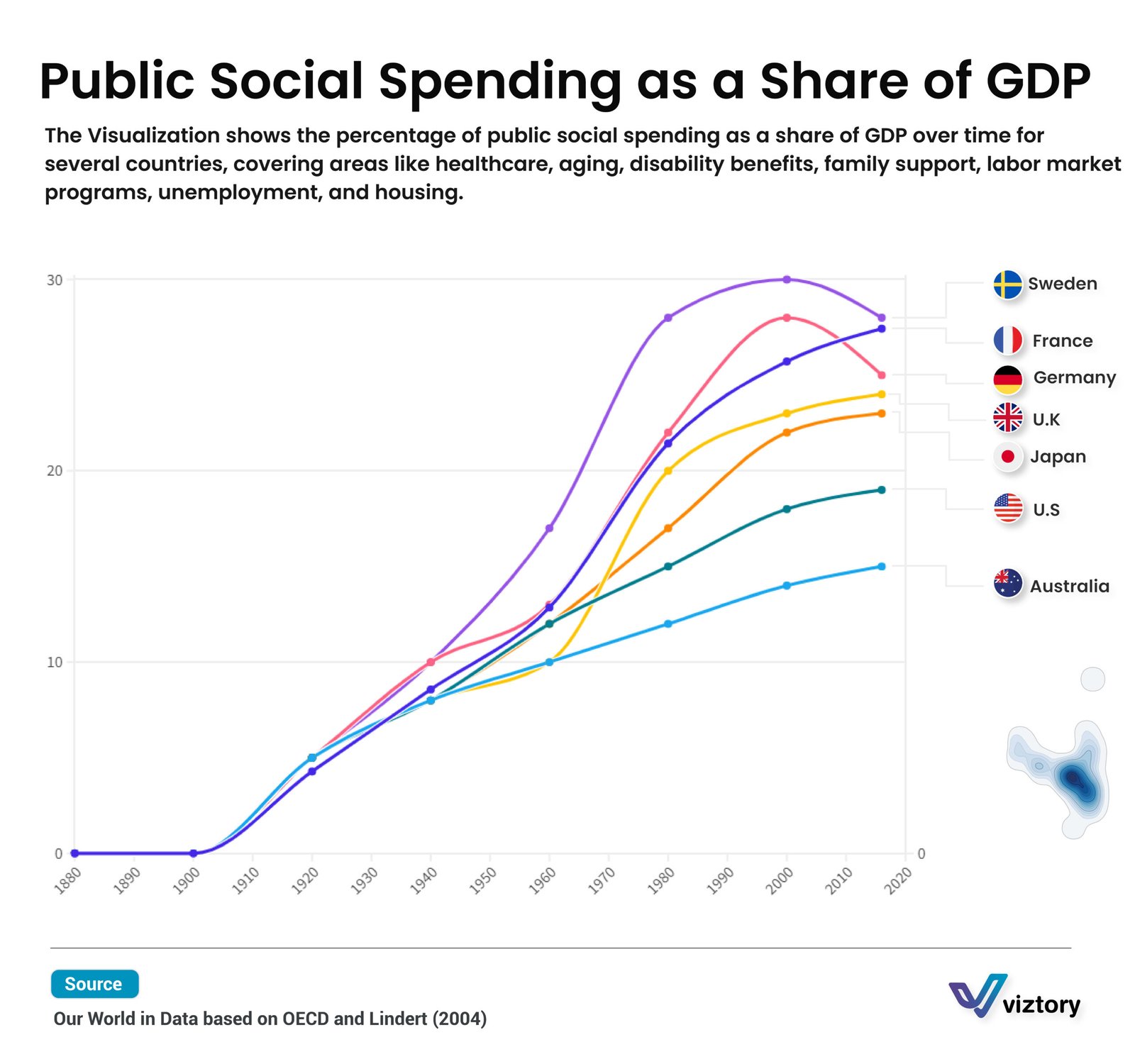Public Social Spending as a Share of GDP: Financial Implications and Global Trends
-
Sep, Tue, 2024
Public Social Spending as a Share of GDP: Financial Implications and Global Trends
The chart illustrates the evolution of public social spending as a share of Gross Domestic Product (GDP) in several major economies, including Sweden, France, Germany, the United Kingdom, Japan, the United States, and Australia. This public social spending encompasses areas such as healthcare, aging-related services, disability benefits, family support, labor market programs, unemployment benefits, and housing. Over the past century, this type of spending has seen substantial growth in developed countries, reflecting a larger role for governments in addressing social and economic inequalities.
Social Spending and Economic Management
Public social spending directly reflects a nation’s commitment to the welfare of its population, particularly vulnerable groups. As shown in the chart, countries like Sweden and France lead the world in social spending as a percentage of GDP, each dedicating close to 30%. This indicates robust welfare systems that provide comprehensive healthcare, pensions, and unemployment benefits. Such spending can promote economic stability by ensuring that citizens have access to essential services during economic downturns, helping mitigate the effects of financial crises on households.
However, such high levels of social expenditure come with financial challenges. Larger spending often requires higher taxation, government borrowing, or cuts to other areas of public expenditure. Managing these trade-offs can be complex, as governments must balance their budgets while ensuring the financial sustainability of their welfare systems. Sweden, for instance, relies on higher tax rates to finance its social programs, while the United States and Japan, which spend significantly less, may focus more on private insurance or market-based solutions to meet social needs.
Public Spending and Economic Growth
The relationship between public social spending and economic growth is a subject of ongoing debate. On the one hand, substantial social investment can drive economic growth by fostering healthier, better-educated, and more secure populations. For example, countries that invest heavily in healthcare and education tend to have more productive workforces, which can boost long-term economic output. In this context, social spending is seen not only as an expense but as an investment in human capital.
On the other hand, excessive public spending relative to GDP can strain a country’s finances, potentially leading to higher debt levels or inflation if not carefully managed. For example, Japan faces rising public debt partly due to its aging population and the corresponding need for higher social spending. Managing this type of public expenditure requires careful financial planning, as unchecked spending can limit economic flexibility and reduce growth prospects.
Global Trends in Social Spending
The graph indicates that public social spending has risen significantly across all the highlighted countries, particularly after World War II. This trend reflects broader changes in economic structures, with welfare states becoming more prominent in the second half of the 20th century. This shift was driven by a desire to provide social safety nets for aging populations and support those facing economic hardship, such as during periods of high unemployment.
Sweden and France maintain the highest levels of public social spending, with Germany and the United Kingdom following closely behind. These European nations have historically prioritized strong social safety nets, reflecting their belief in the government’s role in managing societal well-being. Conversely, the United States and Australia are characterized by lower public social spending, where social safety nets are more market-driven, relying on private sector solutions alongside government programs.
Conclusion: The Financial Balancing Act
Public social spending as a share of GDP provides critical insights into how governments allocate financial resources to address social needs. While increased spending on healthcare, pensions, and other welfare programs is essential for maintaining social stability, it also requires careful financial management to ensure that it does not lead to unsustainable economic challenges. Each country’s approach to social spending reflects its unique financial strategies, cultural values, and economic goals. As countries face the challenges of aging populations, healthcare costs, and social inequality, the balance between maintaining public welfare and managing financial stability will remain a critical issue for the global economy.

